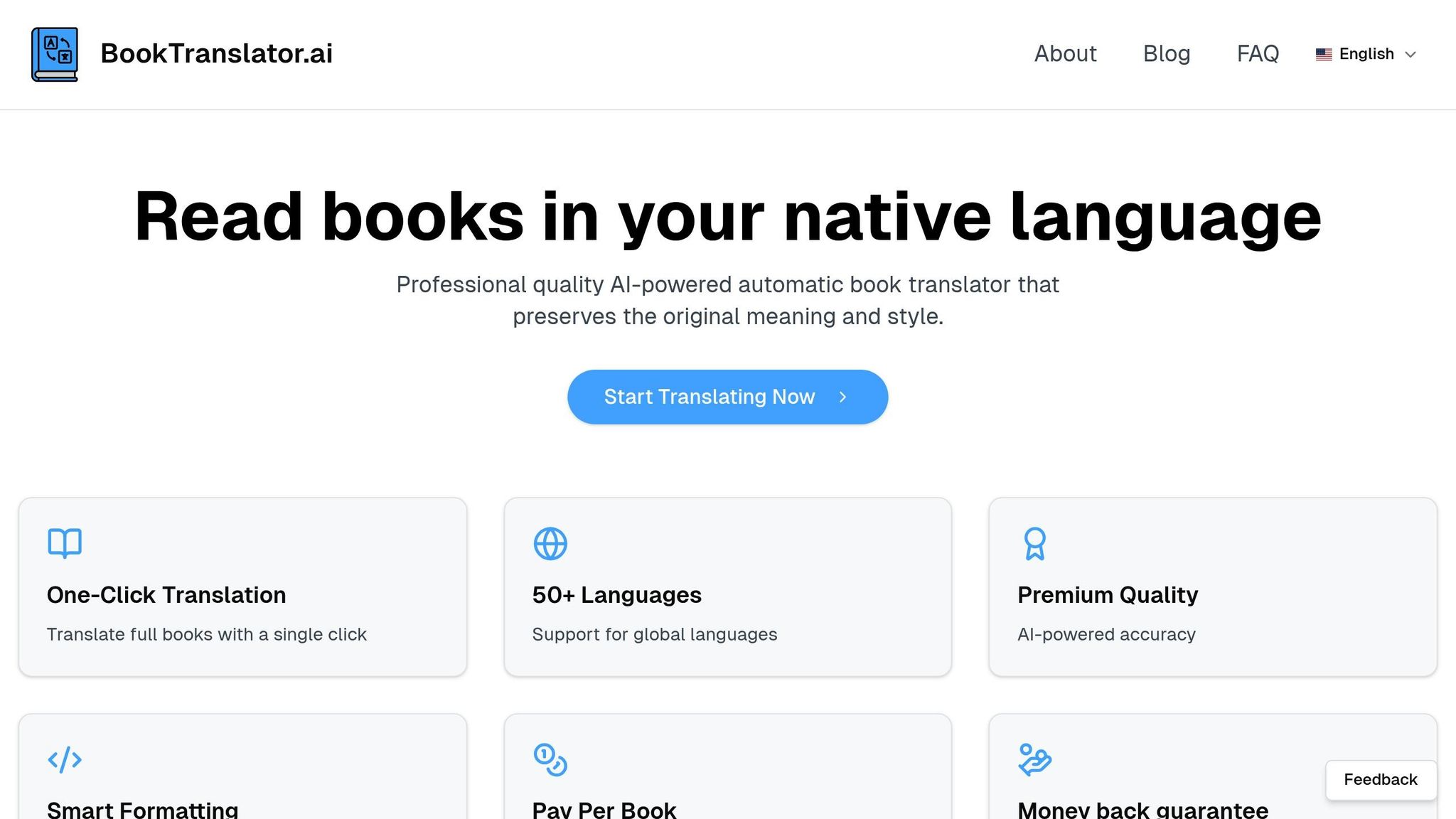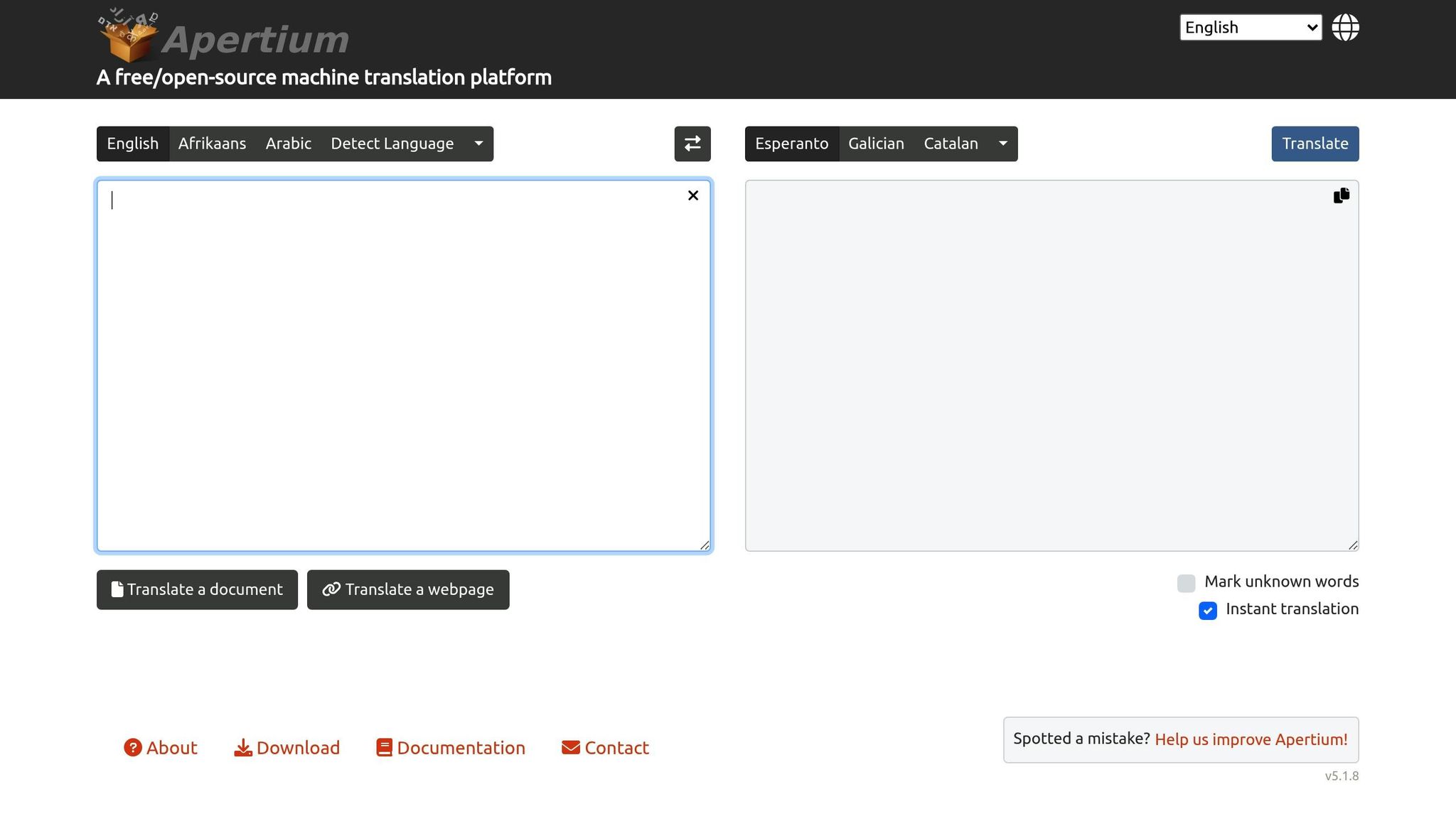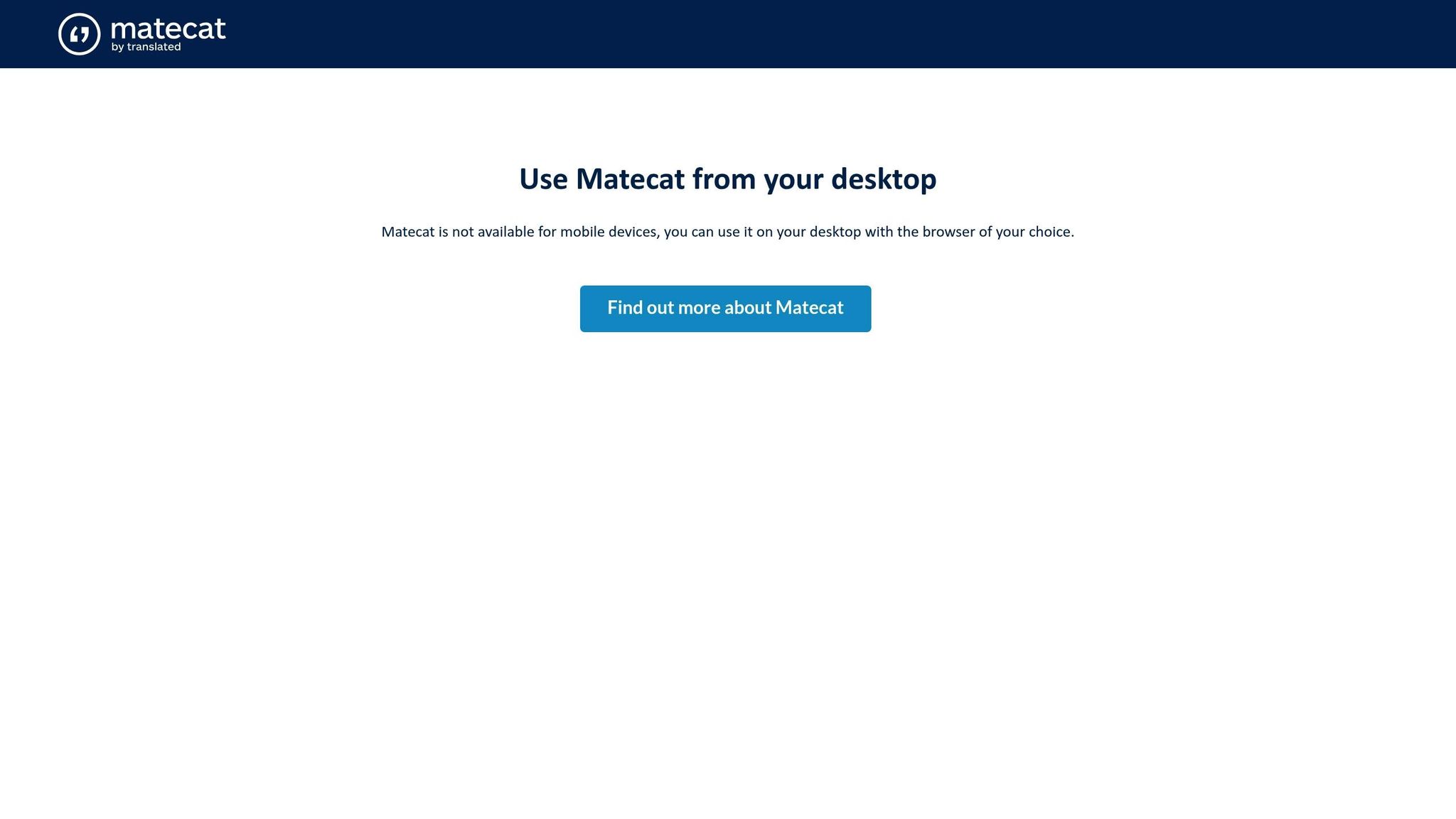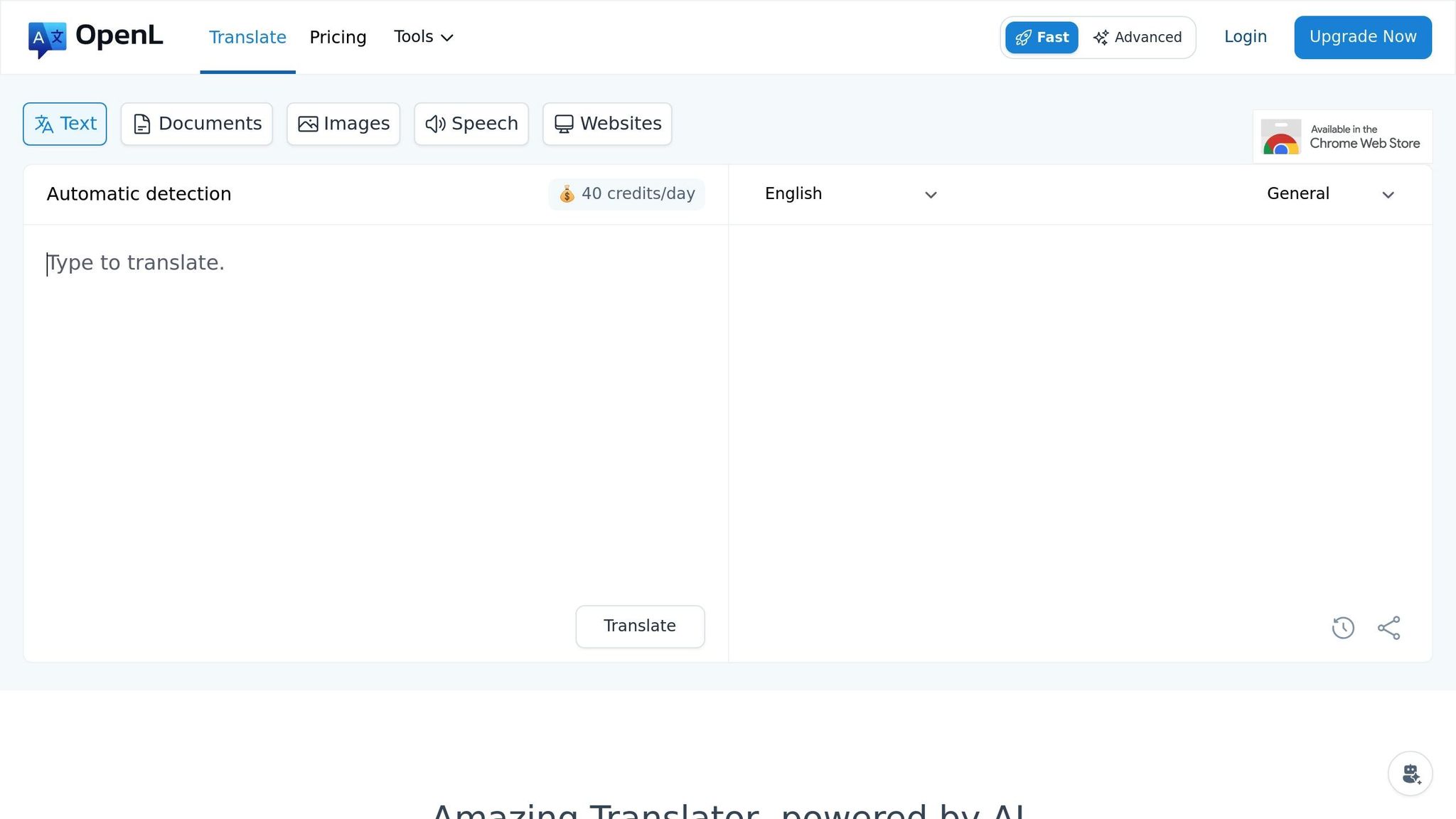
Open-Source Tools for Rare Language Translation
Translating rare languages is challenging, but open-source tools are making it easier. These tools help communities preserve their languages and ensure accurate translations by involving native speakers and offering affordable, flexible solutions. Here's what you need to know:
- Rare languages often lack digital resources like standardized scripts or parallel datasets, making translation difficult.
- Open-source tools enable collaboration, transparency, and community-driven customization for translations.
- Key challenges include limited data, unique grammar, idioms, and resource constraints.
- Popular tools include BookTranslator.ai, Apertium, MateCat, LUMI, and OpenL Translate, each catering to different needs like literary translation, grammar consistency, or collaborative projects.
Quick Overview of Tools:
- BookTranslator.ai: Great for translating EPUB books while keeping style and format intact. Costs $5.99–$9.99 per 100,000 words.
- Apertium: Rule-based, excels in grammar but needs linguistic expertise for setup.
- MateCat: Ideal for collaborative efforts with translation memory features.
- LUMI: Designed for endangered languages, focuses on community involvement.
- OpenL Translate: Highly customizable but requires technical skills.
The key to success is combining tools, involving native speakers, and prioritizing quality control. Open-source platforms are transforming rare language translation by addressing specific challenges and empowering communities.
Reviving Vanishing Languages
Best Open-Source Tools for Rare Language Translation
Open-source translation tools have become indispensable for communities working with rare languages. Each tool brings its own strengths to the table, offering unique solutions for different translation challenges. Understanding what these tools offer can help you make an informed choice for your specific needs.
Here’s a closer look at some of the standout tools available for translating rare languages.
BookTranslator.ai

BookTranslator.ai is an AI-driven platform tailored for translating EPUB books into over 99 languages. What sets it apart is its ability to preserve the original meaning, style, and formatting of the text. With just one click, users can translate entire literary works while maintaining their layout and integrity. Pricing starts at $5.99 per 100,000 words for the Basic plan and $9.99 per 100,000 words for the Pro plan. The platform supports EPUB files up to 50 MB and even offers a money-back guarantee, making it a reliable choice for translating large-scale projects.
Apertium

Apertium is a rule-based machine translation system that works particularly well with languages that have well-documented grammar. By using predefined linguistic rules, it produces consistent translations, though it may require further tweaking to handle idiomatic expressions effectively. This makes it a solid choice for users who prioritize grammatical accuracy and are comfortable refining translations manually.
MateCat

MateCat is an open-source platform designed for collaborative translation projects. Its standout feature is the translation memory, which stores previously translated segments. This ensures consistency across projects and reduces repetitive work. MateCat is especially useful for community-driven initiatives, allowing native speakers from different locations to collaborate seamlessly. However, since translations are processed on external servers, users should be mindful of potential privacy concerns.
LUMI
LUMI is a specialized tool aimed at supporting endangered language communities. It takes a community-first approach by involving native speakers in the training process to refine its translation models. This ensures the translations align with traditional usage patterns and cultural protocols. Beyond translation, LUMI integrates with efforts to document, teach, and revitalize at-risk languages, making it a valuable resource for language preservation.
OpenL Translate

OpenL Translate combines artificial intelligence with the transparency of open-source tools to tackle rare language translation. One of its key strengths is the ability to train custom models using community-provided texts. This ensures translations reflect local dialects and cultural nuances. The tool features a user-friendly interface that caters to both beginners and advanced users, with options for customization. OpenL Translate also supports incremental learning, allowing its models to improve over time as users contribute corrections and feedback. This flexible design empowers indigenous groups to maintain control over their linguistic data while tailoring the tool to their specific needs.
Each of these tools offers something unique, whether it’s ease of use, collaborative features, or a focus on language preservation. By exploring these options, you can find the right fit for your rare language translation needs.
Building Collaborative Platforms for Rare Language Data
Translating rare languages depends heavily on having access to high-quality data. Unlike widely spoken languages with an abundance of digital texts, rare languages often lack the extensive datasets required to train effective translation models. This is where collaborative platforms step in, uniting native speakers, linguists, and tech enthusiasts to create comprehensive language resources. These efforts not only support translation but also contribute to preserving these languages for future generations.
Why Collaboration Matters
Traditional methods of gathering language data often overlook smaller language communities. Crowdsourcing changes the game by drawing on the collective expertise of native speakers from around the world.
The strength of community-driven data collection lies in its ability to capture authentic language use. Native speakers bring an understanding of regional nuances, cultural contexts, and subtle meanings that outsiders might miss. When they contribute to translation datasets, the result is a resource that reflects how the language is actually spoken and understood in daily life.
Collaborative platforms also tackle the challenge of sustainability that many rare language projects face. Instead of depending on a single researcher or institution, these platforms rely on distributed communities to maintain and enhance datasets over time. This decentralized model helps protect projects from disruptions caused by funding cuts or personnel changes.
As more contributors join, the value of the dataset grows. Each new participant adds fresh vocabulary, expressions, and localized knowledge, enriching the resource for everyone. This snowball effect ensures that collaboration produces datasets with greater depth and diversity.
Dataset Creation Best Practices
For collaboration to produce meaningful results, it’s essential to establish clear standards and guidelines. High-quality datasets for rare languages don’t just happen - they’re the result of careful planning and consistent practices.
Start by providing clear guidelines to contributors. These should outline the type of content needed and how to format it correctly. This clarity ensures that everyone is on the same page from the beginning.
Prioritize linguistic accuracy by implementing a robust review system. A three-tier validation process - contribution, peer review, and expert approval - can help catch errors and ensure that the data meets high standards.
Consistency is key, especially when dealing with languages that have unique writing systems or multiple romanization methods. Standardized formatting for punctuation, capitalization, and special characters ensures that the dataset can be used across various tools and platforms.
Include metadata about contributors, such as their dialect, region, and level of expertise. This information not only improves the reliability of the data but also allows for better filtering and quality control.
Use version control to track changes over time. Just like in software development, this approach helps maintain a clear history of edits, corrections, and additions. It also allows communities to undo problematic changes if needed.
Finally, adopt open licensing to ensure that the dataset benefits the broader community. Licenses like Creative Commons allow others to build on the work freely, encouraging wider use and preventing the data from being locked behind proprietary restrictions.
Successful Collaborative Projects
Several initiatives have shown how effective community-driven platforms can be for rare language data collection. These projects offer valuable lessons for anyone looking to create similar efforts.
The Common Voice project by Mozilla has gathered speech data for dozens of languages, including many that are rare or endangered. By using simple web-based tools and gamification features, they’ve made it easy and engaging for contributors to participate. Users can record their voices and validate recordings from others, creating a rich and diverse dataset.
Wikimedia's language projects go beyond Wikipedia to include tools like Wiktionary, which documents vocabulary and usage patterns for languages with limited digital presence. The collaborative editing model allows native speakers to continually refine and expand the entries, ensuring accuracy and relevance.
Some Indigenous language communities have developed their own platforms. For example, the FirstVoices platform supports Indigenous groups in North America by providing tools to create digital archives of their languages. These archives include audio recordings, translations, and cultural context, all managed by the communities themselves to ensure sensitive information is handled appropriately.
Academic collaborations have also been highly effective. The Universal Dependencies project brings together linguists from around the globe to create consistent grammatical annotations for over 100 languages. Their shared guidelines and regular data releases have become a key resource for computational linguistics research.
What these projects have in common is a focus on community ownership, user-friendly tools, quality control, and long-term sustainability through diverse funding sources. They also recognize that building datasets for rare languages is more than a technical task - it’s a cultural and social effort that requires sensitivity to the needs and values of the communities involved. These examples show how collaboration can transform isolated efforts into lasting resources for both translation and preservation.
Collaborative platforms mark a shift from traditional, top-down approaches to language documentation. By empowering communities to take charge of their linguistic data, these initiatives create resources that are not only more accurate but also more enduring, serving both current translation needs and the goal of preserving rare languages for generations to come.
sbb-itb-0c0385d
How to Use Open-Source Tools Effectively
Making the most of open-source translation tools for rare languages takes careful tool selection, a smart mix of methods, and a structured approach to post-editing. While strategies for widely spoken languages often fall short for rare ones, a customized plan can help preserve and translate these languages more accurately.
Selecting the Right Tools
Start by evaluating the language family, the data you have, and the technical skills needed for each tool. Language family relationships play a big role in how effective a tool will be. For example, if you're working with a Bantu language, tools trained on related languages will likely outperform those designed for Indo-European languages.
The available data also matters. Rule-based systems like Apertium can work well with limited parallel texts since they rely on linguistic rules rather than large datasets. On the other hand, AI-driven tools require more data but can handle subtleties that rule-based systems might miss.
Match the tool to your resources and expertise. For example, LUMI is a good choice for linguists with less technical experience, while OpenL Translate offers more flexibility but requires more configuration.
Don’t overlook community support. Check if the tool has active documentation, regular updates, and a user base working with similar languages.
It’s also important to consider integration needs early on. Make sure the tools you choose can share data formats to avoid workflow issues.
For literary translation projects, BookTranslator.ai is worth exploring. It’s designed to maintain formatting and style across a wide range of languages, including rare ones. Its one-click translation feature is particularly useful for handling complex document structures that general-purpose tools might struggle with.
Once you’ve chosen your tools, combining rule-based and AI methods can take your translations to the next level.
Combining Rule-Based and AI Methods
For rare languages, blending rule-based and AI approaches often delivers the best results. Each method has its strengths: rule-based systems are great for consistency, while AI methods excel at understanding context and adapting translations based on surrounding text.
A good starting point is using rule-based systems to establish a baseline. These systems can handle basic grammar and common vocabulary reliably. Then, refine the output with AI tools to address areas where context is key.
Preprocessing with rules can make AI tools more effective. For example, rule-based systems can handle proper nouns, dates, and numbers before the text is fed into an AI model. Similarly, post-processing with rules can catch and fix common errors made by AI systems, improving overall accuracy.
The key is iterative improvement. Start with a rule-based translation, enhance it with AI, and then apply additional rules to correct recurring issues. Each cycle helps improve the final output.
After integrating your tools, the next step is to focus on systematic post-editing.
Post-Editing for Better Accuracy
Machine translations for rare languages almost always need human review. But instead of making random corrections, a strategic approach to post-editing yields better results.
Focus on high-impact errors first. Errors that change the core meaning of a sentence are more critical than minor grammatical issues. Address mistranslations of key concepts before worrying about perfect grammar.
Identify common error patterns to fix recurring mistakes more efficiently. Instead of correcting the same errors repeatedly, tackle them systematically. Also, use native speakers strategically - match their expertise to the content, whether it’s understanding cultural nuances or technical terminology.
Set clear quality benchmarks. The level of accuracy you need depends on the purpose of the translation. A rough draft for internal use doesn’t require the same level of polish as a document intended for publication. Clear benchmarks help avoid over-editing and save time.
Create feedback loops to refine your process. For example, if certain errors keep coming up, you might need to adjust your tool selection. Document your editing decisions to guide future editors and improve workflows.
The goal is to strike the right balance between accuracy and efficiency, enhancing the machine translation output without completely rewriting it.
Open-Source Tool Comparison: Pros and Cons
When it comes to translating rare languages, the choice of tools depends heavily on your specific goals, technical know-how, and available resources. Each platform has its own strengths and challenges, so understanding these can help you make an informed decision. Below, we break down the pros and cons of some popular tools by considering factors like accuracy, ease of use, customization, cost, and limitations.
BookTranslator.ai is a standout choice for literary translation, particularly for EPUB files. It boasts impressive accuracy - 95% for English–Catalan translations and nearly flawless results for Portuguese [1]. The platform simplifies the process with one-click translation while preserving intricate EPUB formatting.
On the flip side, BookTranslator.ai is narrowly focused on EPUB files and operates on a pay-per-book model, starting at $5.99 per 100,000 words [1]. This pricing works well for book projects but may not be practical for organizations handling diverse or high-volume content.
Apertium shines with its rule-based approach, offering strong grammatical consistency and accuracy. It’s especially useful for languages with limited digital resources, as it requires minimal training data. Plus, its open-source framework allows for extensive customization.
However, Apertium has a steep learning curve, requiring linguistic expertise to create effective rule sets. It also struggles with context-sensitive translations and idiomatic expressions, which are often vital in rare language projects.
MateCat is built for collaboration, making it a great choice for community-driven translation efforts. Its translation memory feature ensures consistency across large projects, and it supports a variety of file formats. The platform’s collaborative tools allow multiple translators to work on a project simultaneously, which is particularly helpful for dispersed teams.
That said, MateCat relies heavily on existing translation memories (TM) and is geared toward professional workflows, which might not suit all users.
LUMI offers a straightforward, accessible option, especially for academic researchers and volunteers. Its user-friendly interface requires little technical setup, and it integrates well with other linguistic tools while supporting multiple data formats.
The trade-off is that LUMI offers limited customization and may not handle highly specialized or technical content as effectively as other platforms.
OpenL Translate provides maximum flexibility for complex projects. Its modular design allows for the integration of various translation methods and custom linguistic rules, making it highly adaptable.
The downside? OpenL Translate is complex to set up and maintain, requiring significant technical expertise, which can be a barrier for some users.
These comparisons highlight the importance of aligning your tool choice with the specific demands of your project. In many cases, combining multiple tools in a workflow can yield the best results, leveraging the unique strengths of each platform at different stages of the translation process.
Tool Comparison Table
| Tool | Best For | Accuracy | Ease of Use | Customization | Cost | Main Limitation |
|---|---|---|---|---|---|---|
| BookTranslator.ai | Literary translation, EPUB files | Very High (95%+ for rare pairs) | Excellent (one-click) | Limited | $5.99-$9.99/100k words | EPUB format only |
| Apertium | Rule-based consistency | High for grammar | Moderate | Extensive | Free | Steep learning curve |
| MateCat | Collaborative projects | Good with TM | Good | Moderate | Free/Premium tiers | Requires existing TM |
| LUMI | Academic research | Moderate | Excellent | Limited | Free | Basic functionality |
| OpenL Translate | Complex custom projects | Variable | Poor | Extensive | Free | High technical barrier |
Choosing the right tool often comes down to balancing accuracy, resources, and technical expertise. For rare language preservation efforts, using a combination of tools may be the most effective way to address the unique challenges at each stage of the translation process.
Conclusion: Bridging the Accessibility Gap
The world of rare language translation has made great strides thanks to open-source innovation and collaborative efforts. These advancements have leveled the playing field, giving smaller communities and organizations access to translation tools that were once out of reach.
What’s exciting is how these platforms show that high-quality translations don’t always require expensive commercial solutions. They address specific needs in the translation landscape. For instance, BookTranslator.ai stands out by focusing on literary translation, ensuring the original meaning, style, and even formatting of texts are preserved.
Community-driven projects have also proven their worth. Teams of linguists, developers, and native speakers working together have created resources that, in some cases, outperform traditional methods. This is particularly impactful for languages that may not attract commercial interest but hold immense cultural significance.
As these tools evolve, technical barriers are gradually being dismantled. While some platforms still demand technical know-how, others have simplified their interfaces, making rare language translation accessible to researchers and volunteers without programming expertise. This range of usability ensures that projects, regardless of their resources, can find solutions tailored to their needs.
A blended approach - combining rule-based systems, AI technologies, and translation memories - has emerged as a practical way to handle the nuances that pure machine learning might miss.
Key Takeaways
The future of rare language preservation relies on ongoing community involvement and further advancements in open-source translation tools. For organizations working with rare languages, adopting a mix of tools rather than relying on a single solution is often the best strategy.
Open-source tools also offer a clear financial advantage. Platforms like BookTranslator.ai demonstrate how specialized solutions can meet unique translation needs efficiently, without sacrificing quality.
Ultimately, the success of these efforts hinges on the active participation of native speakers and linguistic communities. While technology provides the framework, the authenticity and accuracy of translations depend on the insights of those who truly understand the language’s subtleties and context.
With continuous technological progress and committed community engagement, we can expand rare language translation efforts. The tools available today are already making a difference, but the real challenge lies in scaling these initiatives and ensuring sustained involvement to protect and celebrate linguistic diversity for generations to come.
FAQs
How do open-source tools contribute to preserving rare languages?
Open-source tools are essential in the effort to preserve rare languages. They provide accessible platforms for documenting and sharing linguistic resources like audio recordings, written texts, and multimedia content. These tools allow researchers and local communities to develop AI-powered solutions that can help analyze and revitalize endangered languages, encouraging collaboration and creative approaches.
These technologies also empower indigenous communities to create educational materials, translate content, and safeguard their heritage. By offering flexible and budget-friendly options, open-source tools play a key role in ensuring rare languages continue to thrive as part of the world's linguistic diversity.
What challenges do open-source tools face when translating rare languages, and how can they be addressed?
Open-source tools designed to translate rare languages often struggle with a few key challenges: limited access to training data, scarce linguistic resources, and a lack of bilingual corpora. These gaps can lead to translations that fall short in accuracy. On top of that, capturing and preserving cultural nuances and context during translation proves to be a tough task, often resulting in inconsistent outcomes.
To tackle these challenges, working closely with linguists, applying data augmentation methods, and embracing continuous localization workflows can make a substantial difference. These approaches not only enhance translation quality but also help create better resources for rare languages.
Why is community involvement important for translating rare languages, and how can native speakers help?
Community participation plays a crucial role in translating rare languages. Native speakers offer a depth of understanding, linguistic accuracy, and a sense of authenticity that automated tools simply can't replicate. Their firsthand knowledge ensures translations reflect the true meaning and context of the language.
Native speakers can help in many ways: translating texts, reviewing translations for accuracy, and sharing insights about their culture. They can also contribute to preserving endangered languages by engaging in online forums, producing content, or teaching others. These actions are essential to keeping rare languages vibrant and accessible for generations to come.